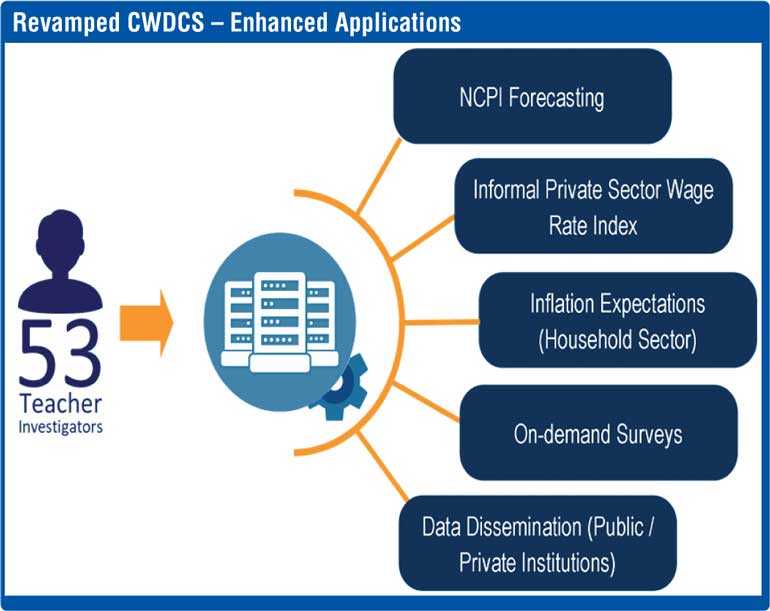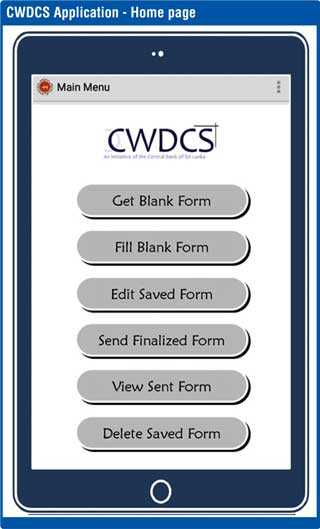Thursday Apr 25, 2024
Thursday Apr 25, 2024
Wednesday, 17 July 2019 00:00 - - {{hitsCtrl.values.hits}}



The economic reforms implemented under the open economic policy introduced in 1977 became a turning point in the evolution of the Sri Lankan economic structure, where the newly-implemented reforms resulted in numerous changes in the socio-economic environment of the country. 
The open economic policy placed greater reliance on the market mechanism by paving the way for the private sector to play a major role in the economy. As a result, government intervention in price determination was reduced markedly causing substantial variations in prices.
At this juncture, in 1978, the Central Bank of Sri Lanka (CBSL) launched a Country-Wide Data Collection System (CWDCS) for the purpose of collecting country-wide market information, such as retail and producer prices of consumer goods and informal sector labour wages, to observe the behavioural changes which occurred in these key economic indicators.
With the intention of ensuring an accurate data collection process, CBSL obtained the services of a set of selected school teachers, on a part-time basis, who were competent in economics and statistics, as statistical investigators to collect the required data from 100 data collection centres established islandwide. The data collected through the CWDCS have been extensively used for assessing the regional differences in prices and wages, compiling price and wage indices, forecasting inflation and thereby facilitating the monetary policy decision making process of the CBSL.
In the early days, CWDCS data collection was carried out manually on a periodical basis. This process consisted of several steps, viz. sending paper-based data collection forms to Teacher Investigators (TIs), collecting data and sending duly filled data forms back to the CBSL by TIs via post, processing data and generating reports. One of the main drawbacks of the manually conducted CWDCS was the long time taken to complete the whole process, including postal delay which was cited by many TIs for the delay in sending data.
As an attempt to address this issue, an e mail-based method for sending forms and receiving data was introduced in mid-2016. However, as manual data entry still consumed a considerable stretch of time, the timeliness of the statistics produced through the CWDCS remained a major concern. Therefore, a need arose to revisit the existing operations of CWDCS to enhance the efficiency of the data collection and transmission arrangement, by way of transforming CWDCS into a high-quality system.
Revamping process of the CWDCS
Inflation forecasting has been paid extra attention, given the CBSL’s plan to move towards a flexible inflation targeting regime by 2020. In this background, with a view to implementing an improved mechanism to provide timely data for inflation forecasting and to reduce required person hours by effectively eliminating wasteful resource usage, the revamping process of the CWDCS was initiated at the beginning of 2017. 
The main objectives of the revamping of CWDCS were to collect retail prices of an identical basket of goods to that of the National Consumer Price Index (NCPI) and informal sector wages at regional levels, thereby enabling CBSL to provide timely inputs for in-house policy making process.
The revamping process consisted of several steps. First, the number of CWDCS data collection centres were downsized to around 53 to match with the price collection network followed by the Department of Census and Statistics (DCS). Then, price and wage collection at district level were streamlined, allocating two collection centres for each district considering the variations in prices and informal sector wages within the district. In this regard, the city centre in each district, together with a center to represent the suburban areas, were selected as price and wage collection centres. However, considering the prevailing price and wage variations, Colombo and Gampaha Districts were allocated with four and three centres respectively. Moreover, data formats were also modified in line with the items in the basket of the NCPI, as the previous CWDCS data collection covered only around 60% of the items relevant to the NCPI basket.
The biggest challenge faced by the CBSL in revamping CWDCS was to establish an online system that ensures connectivity between the TIs and the CBSL facilitating the use of real time data in policy making. Consequently, a tablet-based e-data collection arrangement, ‘CWDCS Application’ aiming at reducing time lag between data collection and compilation to not more than one week was introduced with the technical support of Information Technology Department of the CBSL.
Selecting suitable TIs was another challenge faced by the CBSL in the CWDCS revamping process. In the previous CWDCS, TIs had been selected considering their knowledge in Economics and/or related subjects. However, with the introduction of new ‘CWDCS Application’ it became a pre-requisite for TIs to possess a satisfactory knowledge in Information Technology, in addition to the knowledge in Economics and related subjects. Therefore, new TIs for the revamped CWDCS were selected considering their knowledge in both Economics related subjects and Information Technology, while allowing some of the TIs of the previous CWDCS, who had a sufficient knowledge in Information Technology, to remain in the revamped CWDCS as well.
The CBSL provided the TIs with tablet computers installing the in-house developed software, ‘CWDCS Application’, enabling them to upload the collected data directly from the regional centres. Similarly, hands-on-experience on the use of ‘CWDCS Application’ was provided at the training sessions organised by the CBSL to familiarise the TIs with the software. Subsequently, a test run was conducted for a period of three months in parallel to the manual data collection process of the previous CWDCS. The tablet-based data collection under the revamped CWDCS officially commenced on 1 January 2018 and since then data on retail and producer prices of consumer goods and the daily wages of the informal private sector have been collected on a weekly, monthly and quarterly basis facilitating inflation forecasting, and compiling price and wage indices in a more efficient manner.
With a view to improving data quality received through CWDCS, CBSL conducts on-site and off-site supervisions with the help of both Statistics Department and Regional Offices to identify data outliers and inconsistencies and to take necessary corrective measures whenever required. In addition, five regional seminars for TIs, covering the entire island, are conducted on an annual basis. Seminars are interactive sessions to educate TIs on their common mistakes and give feedback on issues faced by TIs during the data collection process. Moreover, an e-communication platform has been introduced to provide solutions to the issues faced by TIs during the process of data collection. To enhance quality of data, TIs are made aware of current and future price and economic trends during these training sessions.
Beyond collecting prices and wages data
The use of CWDCS has not been limited to collect prices of consumer items and wages of informal sector employees. It has also been utilised to gather inflation expectations, which are used as essential inputs in the setting up of the future path of monetary policy. The Statistics Department of CBSL currently conducts an Inflation Expectations Survey (IES) to measure inflation expectations of household, corporate and academic sectors. The revamped CWDCS network has been added to the respondent base of the household inflation expectation survey and with this extension, CBSL has been able to expand the coverage of the survey from the Colombo district, where the survey was previously limited, to all districts thereby improving the precision of the household sector inflation expectations.
In addition, due to its recognition as a well-established and reliable data collection network that is scattered island wide, the revamped CWDCS network is used by CBSL to conduct on-demand surveys with the co-operation of Regional Offices of CBSL on various socio-economic issues and concerns. One of the recent additions to the system was the Retail Sales Volume Survey developed for the purpose of improving the Gross Domestic Product (GDP) forecasting.
The data and information collected through the CWDCS are not only used internally, but also provided to certain data collecting institutions upon their requests. Moreover, data collected are disseminated for the information of the general public via the CBSL publications on periodical basis.